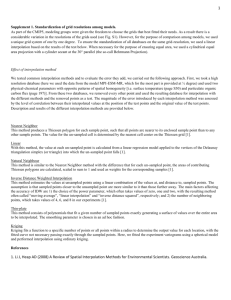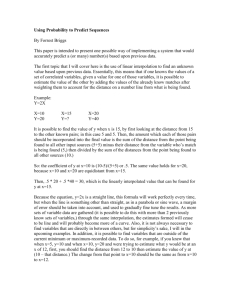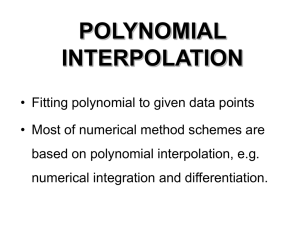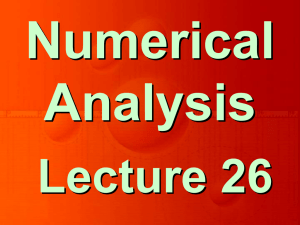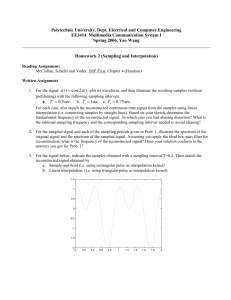LAGRANGIAN INTERPOLATION AND THE RIEMANN ZETA
advertisement
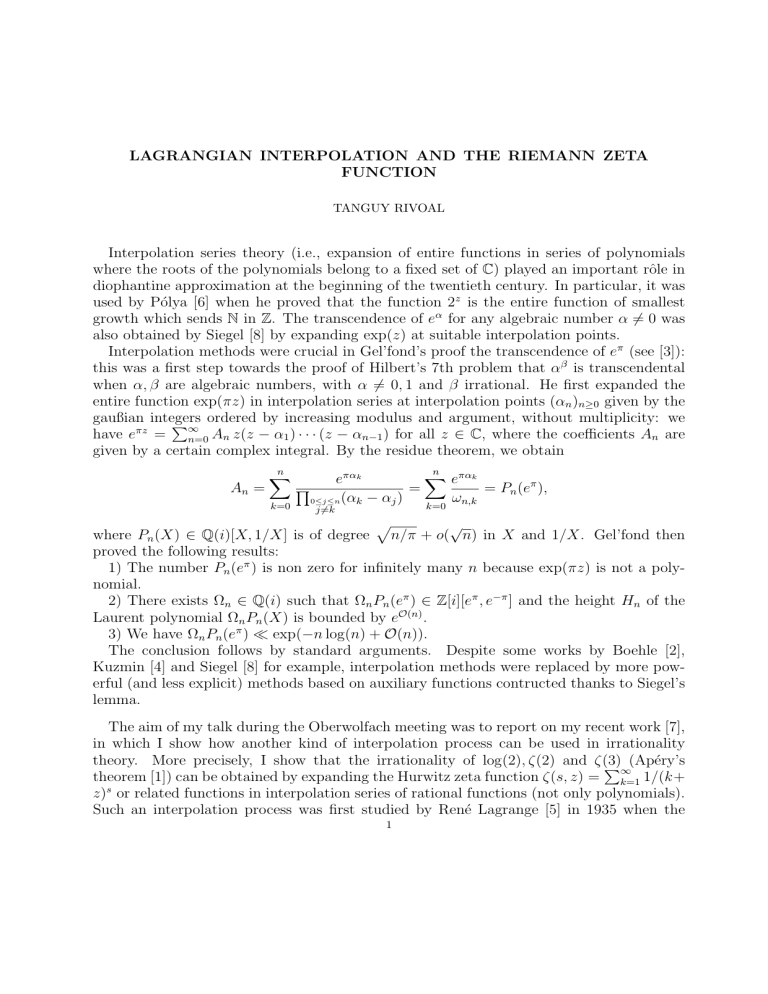
LAGRANGIAN INTERPOLATION AND THE RIEMANN ZETA
FUNCTION
TANGUY RIVOAL
Interpolation series theory (i.e., expansion of entire functions in series of polynomials
where the roots of the polynomials belong to a fixed set of C) played an important rôle in
diophantine approximation at the beginning of the twentieth century. In particular, it was
used by Pólya [6] when he proved that the function 2z is the entire function of smallest
growth which sends N in Z. The transcendence of eα for any algebraic number α 6= 0 was
also obtained by Siegel [8] by expanding exp(z) at suitable interpolation points.
Interpolation methods were crucial in Gel’fond’s proof the transcendence of eπ (see [3]):
this was a first step towards the proof of Hilbert’s 7th problem that αβ is transcendental
when α, β are algebraic numbers, with α 6= 0, 1 and β irrational. He first expanded the
entire function exp(πz) in interpolation series at interpolation points (αn )n≥0 given by the
gaußian integers
P ordered by increasing modulus and argument, without multiplicity: we
have eπz = ∞
n=0 An z(z − α1 ) · · · (z − αn−1 ) for all z ∈ C, where the coefficients An are
given by a certain complex integral. By the residue theorem, we obtain
An =
n
X
k=0
n
X eπαk
eπαk
Q
= Pn (eπ ),
=
ω
0≤j≤n (αk − αj )
n,k
k=0
j6=k
p
√
where Pn (X) ∈ Q(i)[X, 1/X] is of degree n/π + o( n) in X and 1/X. Gel’fond then
proved the following results:
1) The number Pn (eπ ) is non zero for infinitely many n because exp(πz) is not a polynomial.
2) There exists Ωn ∈ Q(i) such that Ωn Pn (eπ ) ∈ Z[i][eπ , e−π ] and the height Hn of the
Laurent polynomial Ωn Pn (X) is bounded by eO(n) .
3) We have Ωn Pn (eπ ) ¿ exp(−n log(n) + O(n)).
The conclusion follows by standard arguments. Despite some works by Boehle [2],
Kuzmin [4] and Siegel [8] for example, interpolation methods were replaced by more powerful (and less explicit) methods based on auxiliary functions contructed thanks to Siegel’s
lemma.
The aim of my talk during the Oberwolfach meeting was to report on my recent work [7],
in which I show how another kind of interpolation process can be used in irrationality
theory. More precisely, I show that the irrationality of log(2), ζ(2) and ζ(3)
P (Apéry’s
theorem [1]) can be obtained by expanding the Hurwitz zeta function ζ(s, z) = ∞
k=1 1/(k+
z)s or related functions in interpolation series of rational functions (not only polynomials).
Such an interpolation process was first studied by René Lagrange [5] in 1935 when the
1
2
degree of the numerators and denominators of the rational summands are essentially equal.
For example, using certain of his formulae, I proved the following:
Theorem 1 (Rivoal, 2006). For all z ∈ C \ {−1, −2, . . .}, we have that
∞
X
∞
(z − n + 1)2n X
(z − n + 1)2n z − n
ζ(2, z) =
+
A2n+1
,
A2n
(z + 1)2n
(z + 1)2n z + n + 1
n=0
n=0
where A0 = ζ(2) and, for all n ≥ 0,
Z
2n + 1
(x + 1)2n
A2n+1 =
ζ(2, x) dx ∈ Qζ(3) + Q
2
2πi
Cn (x − n)n+1
and
A2n+2
2n + 2
=
2πi
Z
Cn
(x + 1)2n x + n + 1
ζ(2, x) dx ∈ Qζ(3) + Q.
(x − n)2n+1 x − n − 1
The curve Cn encloses the points 0, 1, . . . , n but none of the poles of ζ(2, z).
(By definition, (u)0 = 1 and (u)m = u(u + 1) · · · (u + m − 1) for m ≥ 1.) The irrationality
of ζ(3) is a corollary of this theorem. Indeed, by the residue theorem, it is easy to compute
explicitely the coefficient An and to deduce that
d3n An = un ζ(3) − vn ∈ Zζ(3) + Z
where dn = lcm(1, 2, . . . , n). Furthermore, from the integral representation of An , we obtain
that
√
lim sup(d3n An )1/n ≤ e3 ( 2 − 1)4 < 1.
n→+∞
Since ζ(2, z) is not a rational function of z, we necessarily have An 6= 0 for infinitely many n
and the irrationality of ζ(3) is proved.
Similarly, the irrationality of log(2) can be deduced from the following result. Let
e z) =
ζ(1,
∞
X
(−1)n
n=1
n+z
.
Theorem 2 (Rivoal, 2006). For all z ∈ C \ {−1, −2, . . .}, we have
e z) =
ζ(1,
∞
X
n=1
where, for all n ≥ 0,
An+1
2n + 1
=
2πi
Z
Cn
An
(z − n + 2)n−1
(z + 1)n
(x + 1)n e
ζ(1, x) dx ∈ Q log(2) + Q.
(x − n)n+1
e z).
The curve Cn encloses the points 0, 1, . . . , n but none of the poles of ζ(1,
(1)
3
I don’t know if it is possible to obtain the irrationality of ζ(2) by means of R. Lagrange’s
interpolation. Instead, I found new interpolation formulae which enabled me to use rational
functions with unequal degrees for the numerators and denominators. The irrationality of
ζ(2) is then a consequence of the following theorem. By a slight abuse of notations, let
¶
∞ µ
X
1
1
ζ(1, z) =
−
.
n
n
+
z
n=1
Theorem 3 (Rivoal, 2006). For all z ∈ C \ {−1, −2, . . .}, we have
∞
∞
X
(z − n + 1)2n X
(z − n + 1)2n z − n
ζ(1, z) =
An
+
Bn
(z + 1)n
(z + 1)n z + n + 1
n=0
n=0
where A0 = B0 = 0 and, for all n ≥ 1,
Z
1
(x + 1)n (x − n)
An =
ζ(1, x) dx ∈ Qζ(2) + Q
2πi Cn (x − n)2n+1
and
Z
2n
(x + 1)n
Bn =
ζ(1, x) dx ∈ Qζ(2) + Q.
2πi Cn (x − n)2n+1
The curve Cn encloses the points 0, 1, . . . , n but none of the poles of ζ(1, z).
Bibliographie
[1] R. Apéry, Irrationalité de ζ(2) et ζ(3), Astérisque 61 (1979), 11–13.
[2] K. Boehle, Über die Transzendenz von Potenzen mit algebraischen Exponenten (Verallgemeinerung
eines Satzes von A. Gelfond), Math. Ann. 108 (1933), 56–74.
[3] A. O. Gel’fond, Sur les nombres transcendants, C. R. Acad. Sci. de Paris 189 (1929), 1224–1226.
[4] R. O. Kuzmin, On a new class of transcendental numbers, en russe, Izv. Akad. Nauk SSSR 3 (1930),
583–597.
[5] R. Lagrange, Mémoire sur les séries d’interpolation, Acta Math. 64 (1935), 1–80.
[6] G. Pólya, Über ganzwertige ganze Funktionen, Palermo Rend. 40 (1916), 1–16 (1916).
[7] T. Rivoal, Applications arithmétiques de l’interpolation lagrangienne, Preprint (2006), 24 pages, submitted for publication.
[8] C. Siegel, Über die Perioden elliptischer Funktionen, J. reine angew. Math. 167 (1932), 62–69.
Institut Fourier, CNRS UMR 5582 / Université Grenoble 1, 100 rue des Maths, BP 74,
38402 Saint-Martin d’Hères cedex, France
E-mail address: rivoal@ujf-grenoble.fr



